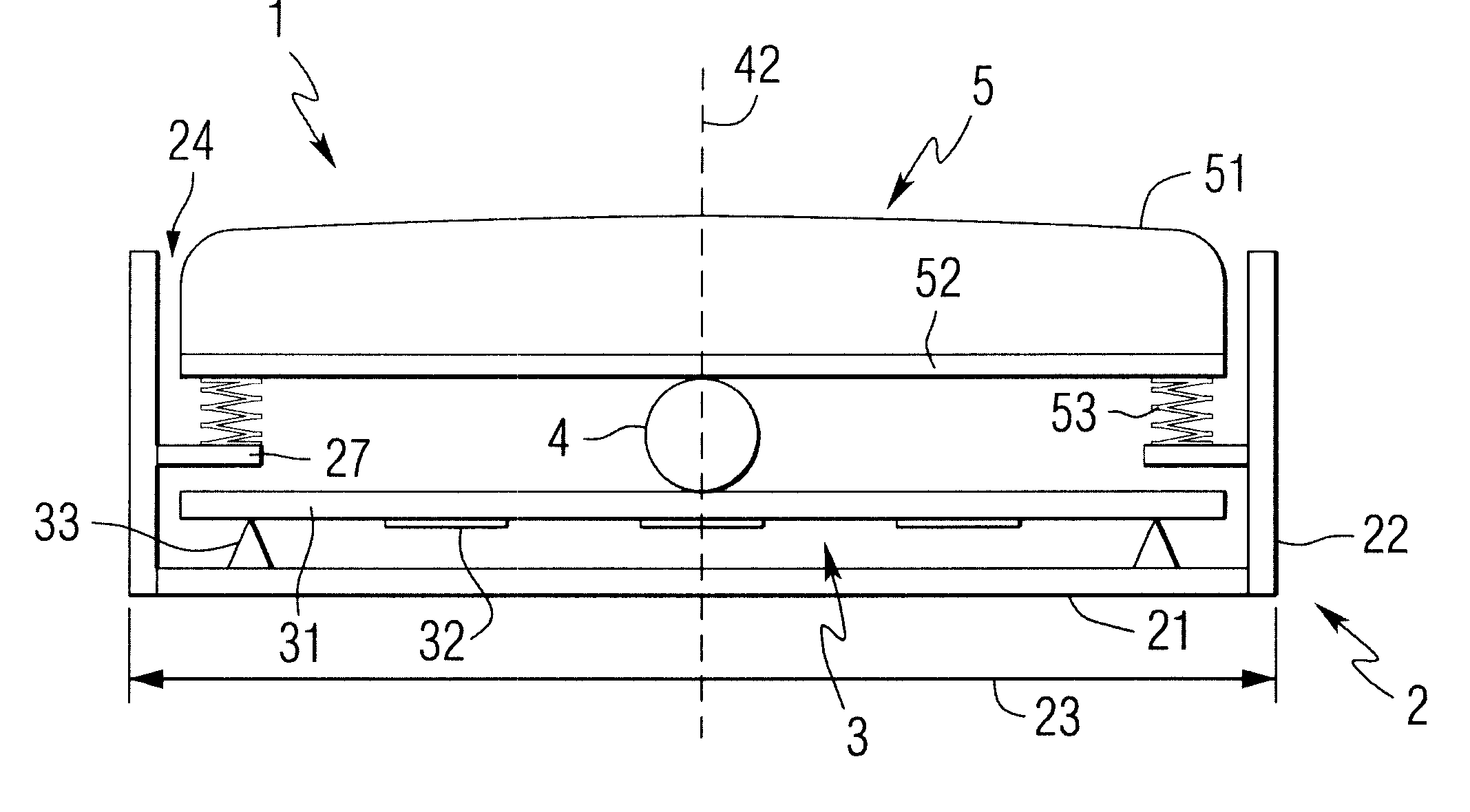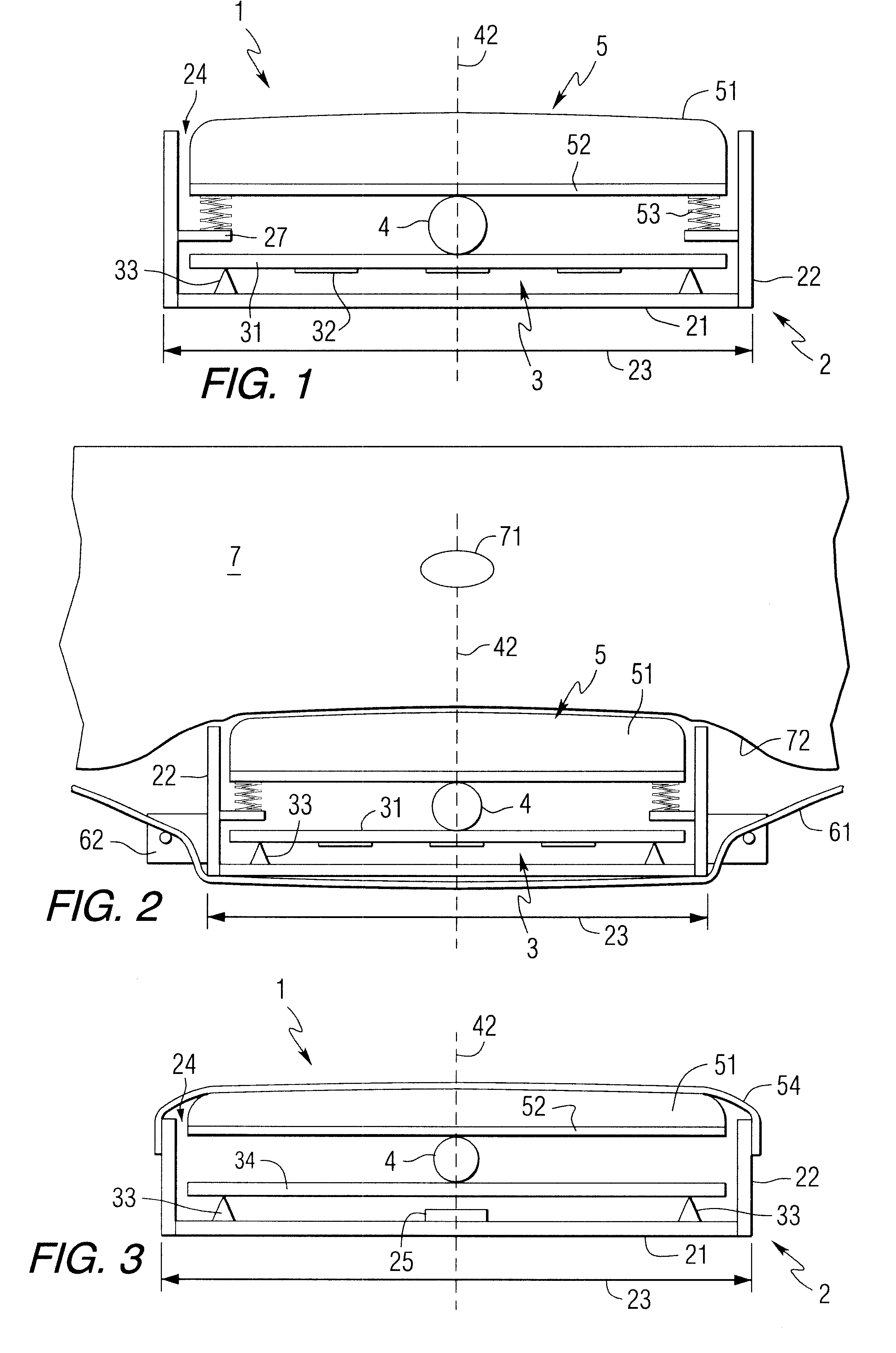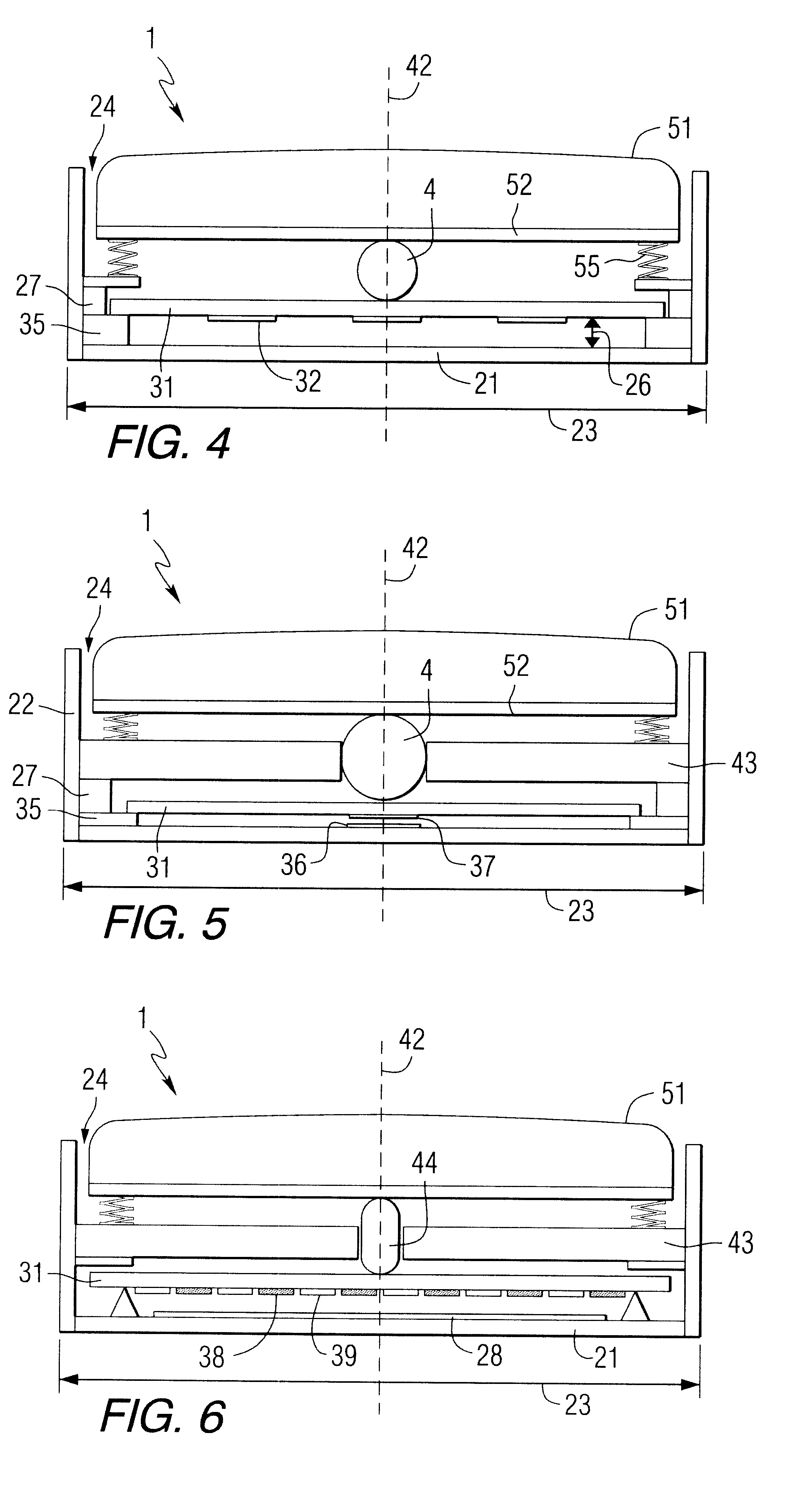In the latter category, devices employing superficially attached electrophysiological electrodes (electrocardiogram (ekg), electroencephalogram (eeg), electromyogram (emg), electrooculogram (eog)) are prevalent, but require skill and
surface preparation for proper
electrode attachment and cause
skin irritation with prolonged use.
However, these devices are quite susceptible to interference from movement and / or ingress of ambient light.
Motion, displacement, vibration and acoustic sensing techniques have also been developed extensively but have yet to see widespread adoption because their inherent sensitivity to movement, location and
noise makes it difficult to interpret
signal changes in a normal
ambulatory environment.
Typically, these devices are quite bulky, demand external power or
compressed air supply and require extensive computation capability.
However, none exist which operate continuously and autonomously without ancillary equipment and without requiring some operation to be performed by the wearer.
However, even on far forward bicycle handlebars the
signal can be lost.
In addition, the readings are affected by other users nearby utilizing similar
heart rate monitors,
electromagnetic radiation interference, particularly from power lines and motorized equipment.
Accordingly, they typically will not work in an automobile, near TV's and computers, and on certain types of
exercise equipment using electric motors and video screens.
While less constraining than an ear clip or
finger stall with their associated wires, the chest band takes time to put on under clothing and is a physical encumbrance to the exerciser.
In addition, it typically only functions when good electrical contact is established to the
skin, either by moistening with water or through sweat during vigorous exercise.
Although this provides feedback while the
exercise equipment is being used, all readings are lost when physical contact with the equipment is broken.
In addition to being uncomfortable, and awkward (because a wire has to be run from the
detector on the ear to a visible display), these devices are prone to interference from movement and changing
ambient lighting conditions.
However the
resultant plethysmographic waveform is readily overwhelmed by motion because movement exerts a strong influence on the dynamics of
venous blood flow and hence
venous blood attenuation of the LED
wavelength.
Accordingly, the patent describes complex and involved
signal processing to recognize the true signal and extract it from exercise-generated noise.
However, the patent provides no enabling disclosure to overcome the motion induced artifacts which would obscure the pulse signal during exercise.
As with the ear-clip, these devices are susceptible to motion and light interference, have external wiring, and are cumbersome and unappealing to wear either during exercise or for routine
pulse monitoring during inactive parts of the day.
While the lightproof
finger stall gives superior results to the LED window types described below, the readings become inaccurate while gripping any object such as a handlebar.
Because the device only works when the user is motionless and the finger is carefully and properly positioned, the watch is equipped with bar displays corresponding to inadequate readings thereby guiding the user to reposition the finger or move into more favorable
ambient lighting conditions.
Clearly, these devices are only suitable for intermittent spot checks on pulse because they only work as long as both hands are being used to make the
electrical contacts.
This is incompatible with exercise and most other types of activity particularly since there is a
delay of several seconds after contacting both electrodes before the pulse is displayed.
These instruments have all of the disadvantages common to IR based devices as described above for the
finger stall and ear lobe types, such as extreme motion sensitivity, and taking several seconds following application of the finger before a pulse reading is registered.
They cannot be used during exercise where hands and arms are involved, and are only useful for occasional discontinuous readings because both hands are needed to take a measurement.
In addition, the instructions issued with these watches reflect numerous practical difficulties with the measurement because of sensitivity to
ambient lighting conditions, sweat and
body hair.
As with the LED window watch, the device is impractical for continuous reading or measurement during exercise because both hands and arms are tied up by the measurement.
In addition, there are electrical contact problems and hence readings become unreliable when the user's
wrist under the
metal backing of the watch is hairy.
Alternatives to the ECG
electrode are microphonic, piezoelectric, photo-optical and capacitative types, but there is no enabling disclosure describing their implementation.
In a non-clinical environment, the signal is confounded by movement, low signal to noise in certain individuals, and poor electrical contact to the
skin.
The patent therefore describes very complex and computationally intensive
signal processing and
pattern recognition schemes (which incorporate a time-consuming learning cycle before any pulse data can be registered) to overcome these extreme difficulties encountered in trying to extract clean pulse data from non-medical, non-chest mounted ECG leads.
While many have been invented and patented, none have been successfully developed into commercially viable products.
Although Pringle states that it is technologically feasible to house the whole device in a watch-type case with the sensor bearing on the radial pulse, no description of the sensor is provided, nor is there any discussion of how to overcome location sensitivity and
motion artifacts.
While numerous methods have been proposed for continuously and non-invasively measuring
blood pressure as an alternative to the invasive arterial line, none have yet reached the point of widespread medical acceptance and commercial availability.
However, the procedure is uncomfortable, expensive, consumes care-provider time and risks
embolization, nerve damage, infection, bleeding and vessel wall damage.
The standard non-invasive device is the automatically inflating pressure
cuff (applied over either the brachial or the
radial artery), which can be uncomfortable with repeated use and only provides discontinuous sample readings at the time the device activates.
Also, frequent
cuff inflations can produce
ecchymosis and nerve damage under the
cuff after extended periods of use.
Accordingly, there would be an unacceptable amount of signal attenuation and even complete drop-out accompanying normal movement.
However, the band used to keep the device on the
wrist does not run over the sensor housing and therefore does not apply pressure to help keep the housing in mechanical contact with the wrist.
In addition, the signal levels from this device would be extremely low and hence difficult to extract from noise because the unimorph disk configuration is relatively stiff and very little force is applied to it by the rod because of the small area of contact between the externally protruding end of the rod and the
artery wall which provides the driving force.
Even with these measures, it likely that the
signal to noise ratio would be inadequate for
pulse measurement with this device, particularly as the signal became obscured by movement and other extraneous phenomena.
Because the film has inherently poor
electromechanical coupling and is applied directly to the skin without any modification to match its
mechanical impedance to the
physiology under test, the example pulse trace is very noisy and must be integrated to smooth the curve and eliminate noise.
The rod is not suitable to be self-contained on the wrist because it incorporates a power-consuming
servo-controlled pressure applying means to compress the
artery to half its thickness and thereby maximize the
signal strength and eliminate artifacts due to circumferential components of the arterial expansion.
Because the sensor is so small, it would have to be very accurately placed and held in position, and the
signal strength would be very susceptible to arm movement or rotation.
However, the technique does not compensate for changes in shape of waveform, and even small movements and noise cause relatively large errors in the
delay time because the transit times are very short along major arteries.
However, the device is not suitable to be self-contained on the wrist because of the computationally intensive
signal processing and the need for bulky and power consuming inflation cuffs and regulators.
While new classes of extremely
pressure sensitive materials and devices are now available in forms that can readily be miniaturized to the configuration of an unobtrusive wrist sensor, none of these can meet the very exacting requirements of a wrist-mounted
pulse sensor without significant modification, and incorporation into systems which accommodate the physiological variables and the motion and noise environment.
In all cases, even though the sensing element is very sensitive, the
pulse pressure wave manifest at the
body surface is so subtle that the
target signal is readily lost in or confused with noise and other environmental influences.
While some inventors have recognized the benefit of capturing arterial displacement signals over a broad area on the surface of the body and have provided relatively large contact pads to accomplish this end, these pads usually contain sensing elements in the contacting surface and therefore do not work satisfactorily for the reasons given in the preceding
paragraph.
The prior art techniques introduce complexity into the
system by attempting to achieve
wide area pick-up by populating the contacting surface area of the pad itself with actual sensing elements.
An additional problem, as will be described below, is that this direct
interfacing technique does not provide enough separation of the signal from the noise.
Automatic gain control circuiting on the signal input is employed, but the patent does not address signal susceptibility to mispositioning and motion.
Accordingly, it is recognized that the device alone cannot combat the problem of noise and motion infiltration hence requiring that the device only be used during very quiet, stationary periods.
While patentees claim the
resultant motion and noise pick-up are significantly diminished, the soft mounting feature greatly reduces the absolute sensitivity of the
piezoelectric beam sensor.
When a high modulus mounting material is used, the depression pressure becomes too high, causing the
pulse wave signal to be distorted.
This places the sensing portion and its mechanical reference (housing) in different
mechanical impedance environments and impairs the above referenced self-canceling effect.
However, overall device height constraints from base to outer contact member necessitate very small displacements of the sensing portion, hence
high stiffness and large signals in response to small motion of said sensing portion.
 Login to View More
Login to View More  Login to View More
Login to View More 


